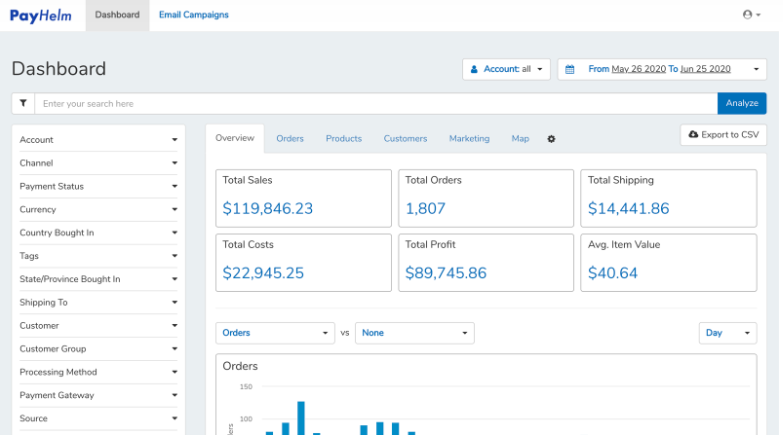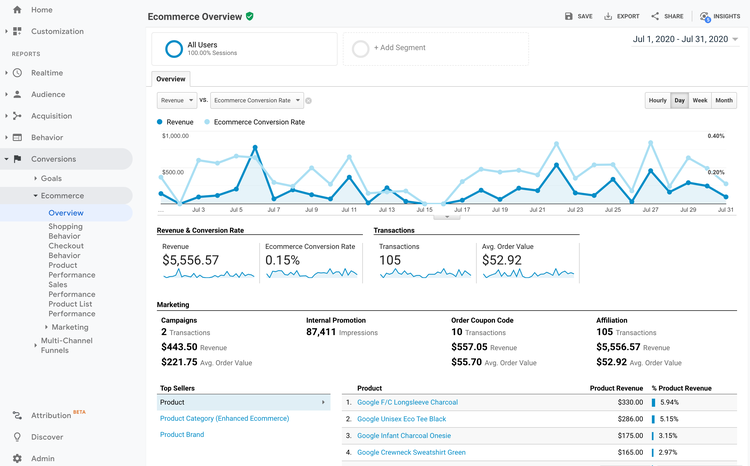If you don’t know how you are doing right now, how can you expect to get results via ecommerce analytics?
When you experiment with new ecommerce marketing strategies, how can you expect to generate sales?
Careful planning is necessary for effective strategies. To assure a better future, successful businesses analyze their past performance and test their hypotheses.
The key to all of this is ecommerce analytics. To help you decide on the best course of action for your company, analytics allow you to dig deeply into the numbers, past financial information, and future predictions.
Although e-commerce statistics can seem intimidating, they are one of the most tangible ways to monitor the development and profitability of your company.
Businesses wouldn’t be able to make wise decisions without the data analytics provided. Many areas of an e-commerce company’s operations, including customer acquisition, customer retention, revenue, and more, can be improved with the aid of analytics.
Once you know what to look for, it’s not difficult to understand analytics. A deeper comprehension of the data that surrounds your firm might help you overcome industry obstacles and boost sales.
In this blog, we highlight the key points of the discussion on ecommerce analytics and discuss how your company may use analytics to maximize the potential of your e-commerce platform.
What is Ecommerce Analytics?
Ecommerce analytics is the practice of compiling information from every source that affects your store. Then, make use of this information to understand changes in consumer behavior and emerging online retail trends.
In the end, basing judgments on data will allow you to make better informed choices, which should lead to an increase in online sales.
A comprehensive range of KPIs related to the entire customer journey, including discovery, acquisition, conversion, retention, and advocacy, can be included in ecommerce analytics.

Why are ecommerce analytics important?
E-commerce analytics give you knowledge about how to draw in clients and track their progress through the sales funnel, among other things. Listed below are just a few advantages of e-commerce analytics:
Sources
Recognize the sources of your clients’ traffic with the use of analytics, such as traffic volume, traffic originating from where, and search terms.
Timing
Recognize the moment at which clients convert: You can observe through analytics when visitors are converting and when they are leaving your site without doing anything. You may boost your conversion rate by using this data to assist you make wise decisions.
Organize and store data
Analytics enables you to save and manage data about your consumers, such as sales, personal information, and more. Additionally, your e-commerce CRM can be integrated with this data.
Enhance customer experience
Analytics give you the knowledge you need to raise customer satisfaction and experience and ensure that your clients are pleased.
Order processing
By using the information supplied by analytics, you may process orders more quickly, automate the order-to-cash management process, and ensure that the fulfillment of orders happens as planned.
What are the types of ecommerce analytics?
You may utilize a variety of ecommerce statistics, as previously discussed, to guide your marketing plan and keep you one step ahead of the competition. Let’s now look more closely at some of the most common categories.
A number of e-commerce variables, like analytics on your site, on social media, and through email, need to be monitored across several platforms. You can use these statistics to monitor KPIs (key performance indicators) for various marketing efforts.
Analytics are a potent weapon in your toolbox, whether you’re monitoring email openings, click-through rates, traffic, or sales.
1. Audience
As was previously mentioned, you may use a range of ecommerce statistics to inform your marketing strategy and keep you one step ahead of the competition. Now let’s take a closer look at some of the most popular categories.
There are multiple e-commerce variables that must be tracked across several platforms, such as analytics on your website, on social media, and through email. These statistics can be used to track various marketing initiatives’ KPIs (key performance indicators).
Regardless of whether you’re keeping an eye on email opens, click-through rates, traffic, or sales, analytics are a powerful tool in your toolbox. Owners of e-commerce businesses can change their shipping policies and advertising strategies based on the geography of their audiences thanks to audience data.
Additionally, you will be able to reconsider the many subjects you cover and the manner in which your marketing content is presented on devices. The types of technologies being used and information on the sessions of your audience are helpful in this situation.
2. Acquisition
Data about client acquisition is another sort of ecommerce analytics that you may utilize to advance your business.
Because you will discover how your visitors found you online and how they got to your website in the first place, this information is really helpful.
You may learn more about the kind of internet marketing channels driving the most traffic to your website by analyzing acquisition data. Additionally, you will discover which channels lead to the most sales or conversions.
Additionally, you may observe firsthand which web marketing channels are effective and which ones are less effective.
– Do the majority of your visits originate from posts on social media?
– How many website visitors do your email campaigns generate?
– What does the conversion rate for your blog content look like?
– Do most of your viewers come from paid advertisements?
This information will be crucial in assisting you in figuring out which marketing channels are the most profitable for your company so that you can choose where to concentrate your resources.

3. Behavior
Information on the behavior of your customers is another piece of data that you ought to examine. How do users act once they arrive on your website?
– What goods do customers ultimately purchase?
– How many visitors leave your website without even looking around?
– Who clicks on which page first?
– What marketing material does the audience click on?
– Which things sell well yet receive a lot of interest?
– How long do visitors typically stay on your website?
These kinds of inquiries can assist you comprehend how your website is currently being used, giving you a better understanding of the regular process customers go through when dealing with your online store.
You should check your website’s page load times if you notice that the majority of visitors don’t scroll through your inventory or leave the page soon. Could it be that your website is taking too long to load?
Users who quickly abandon a page are likely to have been unsuccessful in their search.
This may indicate that they were not expecting your type of business, in which case there may be a problem with the keywords you are using in your marketing campaigns.
Alternatively, it can signal that the material you are creating is merely too muddled.
Overall, behavior analytics will help you identify areas of your store that can be improved.
4. Conversions
Conversions are another form of analytics you may employ to advance your business, as we’ve already said a number of times.
– When do online consumers become paying clients?
– How do online visitors become paying customers?
When it comes to conversion analytics, these are the two questions you are considering. You must consider this aspect of your marketing plan when developing it.
There are many various things you might learn when you start digging deeper.
– How long does it typically take for a user to become a paying customer?
– Do customers typically convert once a year or more frequently?
– Do customers typically purchase things from your online store on their first visit, or do they need to make multiple stops before making a purchase?
– Do customers frequently repurchase products?
– How many customers decide not to buy after adding anything to their cart?
Knowing such information can help you make decisions about your marketing messaging and the most effective ways to engage consumers and potential customers.
It’s crucial that you are also aware of things like the typical revenue your store receives for each transaction.
What’s more, how many goods do your customers typically purchase in a single transaction?
This information is crucial because it enables you to predict the kinds of sales and promotions that will resonate best with your present clientele.
5. Paid Marketing Activities
Your paid marketing activities are yet another important area to take into account in addition to the four analytics we have already covered. You can use this to calculate your precise return on investment (ROI) for different paid marketing efforts.
– How much money did your social media advertisements bring in?
– Have you made more money than you spent making and advertising the advertisements?
– How much money have you made thanks to your pay-per-click advertisements?
– How are your email marketing initiatives going?
If your present paid marketing campaigns are not evaluated, you will just end up spending money on marketing initiatives that have no positive impact on your revenue.

6. Onsite analytics
Analytics collected on-site provide data on how visitors use and interact with your website. Sales, traffic, sales per product, metrics for abandoned shopping carts, traffic sources, search terms, form and button conversions, and other factors can be included but are not limited to.
Because your website is privately owned by you and not under the jurisdiction of social media or other platforms, onsite statistics are particularly significant. They provide you with insider knowledge about your clients that can help you build a rapport with them.
7. Social media analytics
You may learn from social media analytics how clients engage with you on sites like Instagram, Twitter, Facebook, and LinkedIn.
These can include information about your followers as well as engagement and click-through rates for adverts and posts. These analytics can provide you with the knowledge you need to create a social media plan that works for your e-commerce company.
8. Email analytics
You can use email analytics to determine when your emails are effective and to create plans for improvement.
One of the best ways to gather leads and attract targeted, high-quality traffic to your website, personalized email marketing can significantly increase your sales. The size of your email list, email open rates, click-through rates, unsubscribes, and other information can all be included in email analytics.
What are some key ecommerce analytic tools?
You can utilize a number of other crucial tools in addition to the built-in analytics offered by your website, social media platforms, and email marketing platforms to monitor, comprehend, and interpret data about your consumers and your organization. These consist of:
One of the most effective tools you have at your disposal for deciphering data about your website is Google Analytics.
You can track a variety of data about the traffic to, and sales from, your website as well as bounce rates, conversion rates, and other metrics with this fantastic tool. If you’re new to Google Analytics, all of the information may be a little intimidating, but fortunately Google offers a tonne of helpful material to guide you through the procedure.
If you don’t have a place to effectively store and organize the data you gather about your clients, it won’t be of much use to you. CRM softwares enables you to centralize all of your customer data and can help you gain a more complete understanding of each client’s journey.
Using an integrated ecommerce software, you can expedite the sales process and gather all of your analytics data in one location.
Excel may not come to mind when considering ecommerce analytics tools, but it has some unexpected capabilities.
It’s a versatile tool that enables you to perform a wide range of tasks, including producing client invoices and data analysis.
Why do analytics matter for your ecommerce store?
The importance of ecommerce analytics must be established now that you are aware of what they are.
Analytics are important since they help you make decisions that will improve the performance of your online store. We’ll look at some of the key advantages of analytics for ecommerce in more detail in order to successfully show this.
What are the five benefits of analytics for ecommerce?
1. Evaluate the success of your advertising and sales efforts.
Data analytics may help ecommerce businesses make better decisions, get greater omnichannel traction, and inform comprehensive marketing plans.
It can also help them measure the effectiveness of their marketing activities.
2. Evaluate the trends or patterns in data so you can forecast accurately
Ecommerce analytics give you the power to get a better understanding of how your business is performing now and how it is likely to perform in the future.
This forecasting will inform everything from hiring goals and sales goals to making sure that the right products are accessible at the right time so that your customers’ expectations are met.
3. Improve the performance of your pricing, upsell, and inventory.
You will be able to gain insight from a detailed understanding of what influences pricing for each consumer segment thanks to ecommerce analytics.
Using this knowledge, you may find the ideal price points for individual products rather than entire categories, maximizing your earnings.
4. Utilize client information to customize user experiences
To determine what kinds of formats, content, and channels appeal to and resonate with your target demographics, it is essential to understand how customers connect with your organization.
You may utilize ecommerce data analytics to position your products more effectively and make the entire customer buying process better.
5. Incorporate data-driven insights into your approach
You will be able to use data analytics to inform your strategy, which is another advantage of ecommerce analytics.
This will provide you with excellent insight into your company’s operations and the state of the industry as a whole, allowing you to identify some important market trends and potential hazards that you need to address.
What’s the difference between metrics, KPIs, analytics and reporting?
Despite the fact that they are completely distinct from one another, a lot of individuals frequently use these names interchangeably.
Being able to employ all four in concert to achieve the best outcomes is the key to running a successful online store.
You must comprehend what each one signifies in order to accomplish this, so let’s look:
– Measurement standards are known as metrics. Your bounce rate, for instance, might be a measure.
– Reports – A report will include a summary of recent and historical data. It addresses what occurred.
– Key performance indicator, or KPI, is an abbreviation. KPIs are used to gauge levels of success by contrasting actual data with anticipated data. This is the reason something occurred.
– Analytics – Analytics are frequently used to forecast future performance. How can we get better?

What are the best practices for ecommerce analytics?
You should be careful to utilize ecommerce analytics correctly so that you can successfully grow your business now that you have a solid understanding of how helpful they can be. So how can you accomplish this?
1. Gather all of your marketing data that is scattered across all platforms and channels
Given that most firms may have data dispersed across numerous different mediums, it can be a bit of a disorganized beginning place. To arrange your data, you must, however, gather it all together.
You might experience stress. It’s typical. Make a list of the locations you think all of your data is. Here are a few instances of places you could discover crucial information:
– Your store powered by Kilowott
– Emails services
– Platforms for customer relationship management
– Google Analytics Enhanced data for online stores
– Insightful Google Ads
– Instagram Ads
Each company’s list is different and goes on forever. The good news is that consolidating this data can be done quickly and simply.
You can import data into Excel or Google Sheets directly from any source by utilizing a pre-built data adapter. This process doesn’t have to be managed manually, which is a significant improvement.
2. Join the dots between your customers and the numbers
Avoid the pitfall of only collecting data because you feel compelled to. There should be a goal.
You won’t achieve anything by merely studying a sheet of numbers. Nevertheless, the magic happens when you relate these numbers to your clients.
Although marketing technologies offer plenty of data, they were not designed for cross-channel reporting.
However, you won’t be able to fully understand the situation if you only consider the data on their own. At this point, mistakes and bad choices are made.
As your marketing stack expands, having all of your data in one location can help you create a clear picture of your users’ activity so that you can identify areas for improvement.
3. Adjust data for seasonality and other trends
Although it may seem obvious, many online shops fail to adjust their analytics for important market developments, trends, seasonality, or any other changes that may be occurring with the competition.
The secret to success with this strategy is to avoid focusing just on the current state of SEO. This is due to the fact that SEO is a long-term game. As a result, if you only concentrate on micro-moments in the data, you can only depict a very small portion of the broader picture.
4. Keep a close watch over your site’s shopping behavior flow
You may keep an eye on a number of crucial areas in this regard, including sessions involving transactions, sessions involving checkout, and sessions involving add to cart.
If you see a sudden drop in flow, your checkout process may be having problems, and it’s also possible that your website’s speed is experiencing problems. Analysis and observation of this flow are therefore crucial.
5. Track your product categories and individual products over time
Your marketing and sales tracking activities will benefit from looking at detailed product information.
You can identify your key revenue generators by monitoring the success of your product category and individual products over time. If you want to figure out which things are working well and which ones aren’t working as well as you had hoped, this is a wonderful place to start.
You can delve deeper by examining the sales results for each of your products under a certain category.
To find out what your consumers are actually interested in and which things may use a little more love, look for the best-performing items that have the biggest quantity purchased, highest income, and most unique sales.
Make sure your data is accurate and full because no amount of analytics will be of any use if your data is inaccurate or lacking.
Make sure your data collection practices don’t introduce any accidental biases, and keep a watch out for irregularities in your statistics.

How to begin your ecommerce analytics strategy?
You must first respond to three important questions before implementing your analytics strategy:
– What is it that you hope to gain from analytics?
– What theory do you wish to be verified?
– How will you evaluate your performance?
Create a measuring plan after having the answers to these questions, and then pick the appropriate tools.
The data you have about online behavior needs to be combined with offline data or e-commerce transactional data.
You must combine these facts to gain the whole picture and develop a comprehensive understanding of your customer.
When beginning your B2B analytics project, be careful not to put the cart before the horse because selecting the tools you require is the very last stage.
Wrapping up with ecommerce analytics
You now know everything there is to know about e-commerce analytics and why it’s so crucial for your company.
You may use data to help you make more informed decisions that will advance your business and enhance your bottom line.
You can only do this if you want to know which parts of your company are doing well and which ones need to be changed and improved. You cannot enhance something if you don’t measure it.
We empower companies from across the retail and ecommerce sector, to offer everything from online webstores to tracking solutions that can bolster online selling of your products.
Need help? Let’s talk






